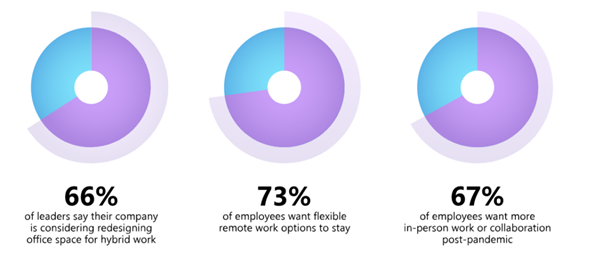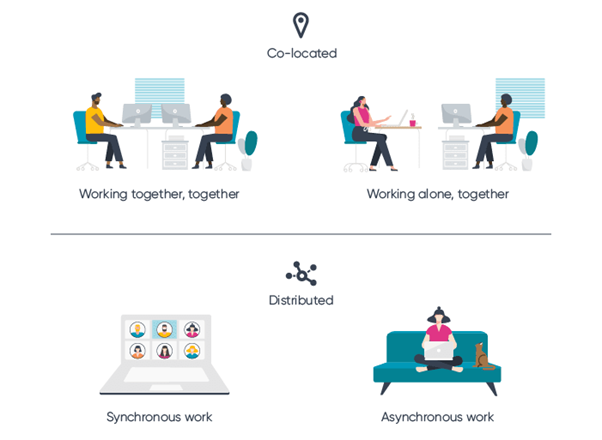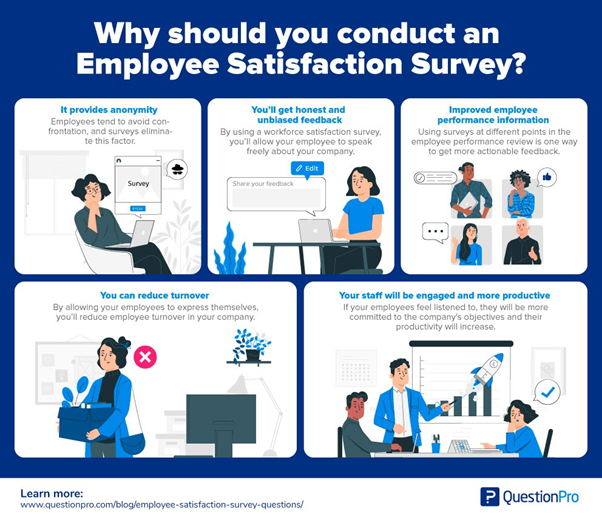Over the last couple of years, a revolution has been taking place in the working environment thanks to the pandemic. As a result, the workplace has transformed itself as people became accustomed to working and collaborating at the kitchen table rather than the office. Not only did it impact the way we socialize and work, but it also speeded up the rate at which technology develops and is adopted.
As we emerge from a post-pandemic world, businesses around the world will have the opportunity to redefine how the workplace looks. For many, the hybrid workplace is a very attractive concept. In fact, 83% of workers prefer to work in a hybrid workplace, but there are various factors impacting their ability to thrive in this kind of environment.

First things first, what exactly is a hybrid workplace and how can you implement it in your company?
What is a Hybrid Workplace?
Hybrid workplaces are business models that combine the flexibility of remote work with the efficiency and productivity of those who work from offices. These businesses provide workers with the opportunity to decide where they're most comfortable working - at home, in a traditional office setting, or partly out of each.
The reason for this is simple: it provides people with the chance to do their best work thanks to its all-encompassing atmosphere that engulfs them, therefore, allowing them to be as productive as possible.
It’s fair to say that many offices were hybrid workplaces before the pandemic, but moving forward, it’s likely that the balance of remote and in-office workers will be different. In general, there are also going to be a larger number of remote workers.
The preference for long-term hybrid and/or remote work is not merely a matter of personal preference. It's also about productivity, as 78% of workers surveyed by The Harris Poll on behalf of Sungard AS said they believe themselves to be more productive if allowed to choose between working at home or from their office workspace when needed.
How to Maximize Collaboration and Productivity in a Hybrid Workplace
If you’d like to adopt a hybrid workplace business model, increasing employee productivity has to be at the top of your list of priorities. After all, it’s what will make a significant difference to your company’s performance and drive your competitive advantage.
But how best to go about it?
There are things you can do to maximize collaboration and productivity in hybrid workplaces. Let’s take a quick look at the most important ones.
Set clear expectations
Working in a hybrid work environment combines the flexibility and freedom of working from home with the tools, support, and community found in an office. This is important for all employees to understand since this type of arrangement can be unfamiliar to some people.
Setting realistic expectations between colleagues, making sure that teams have access to basic business tools they may need, adapting scheduled events or meetings that require everyone's attention, and understanding how to effectively use relevant technology are some ways to actively improve a hybrid work environment.
Taking these steps into consideration, others can develop complex business strategies within their own company culture while improving employee efficiency as well.
Also, make sure to set clear goals and appreciate the employees who exceed them. You can even use a no investment merch creation tool to create gifts for them as rewards.
When you make clear what your expectations are, both your company and your employees will benefit from it in all areas:
- your company will have clearer expectations about work
- employees will be less confused with the expectation of working hybrid
- employers can manage their time better by balancing office and remote tasks more effectively
Aligning location with tasks
If you choose to instruct workers on the days they have to be in the office, consider which tasks are better suited for the office and a more collaborative setting. Help employees prioritize which tasks are better suited for different locations.
Tasks such as checking emails, planning upcoming work schedules, and arranging meetings can all be done very effectively at home.
More collaborative tasks, such as meetings or functions that are dependent on the input of others, would be more productive if conducted in person.
Physically change office spaces into spaces that foster collaboration (but in a safe way)
A hybrid workplace is a more fluid environment, and a physical building needs to be able to adapt and flex as things change. The time has come for us to say goodbye to cubicles and closed doors.
A hybrid-work environment is an open workplace setting that allows employees to come and go as they please and contribute in a number of different ways across different areas and/or functions and projects.

For example, there could be an open space that serves several purposes throughout the working day. It might support meetings during the morning, become an eating and socializing area during the lunch hours, host tutorials, seminars, or conferences in the afternoon, and then be hired out in the evening to third parties. No matter what you decide, make sure you follow the proper safety protocols.
Understand employee needs, concerns, and desires
There are no one-size-fits-all solutions as your employee needs, concerns, and desires will be very different. It’s crucial to find a compromise between individual work styles and team needs.
There’s a difference between a solution that fits just Bob and a solution Bob can convince Carol, Dave, and Anna to all agree to. It's crucial to find the middle ground on both sides of the individual work styles spectrum and the team-spirit needs and concerns sphere so everyone feels they have an equal role to play.
Understanding employee needs correctly will help with the planning and decision-making process. If you don’t involve your employees, it could lead to a big disconnect.
Rebalance synchronous and asynchronous work
Synchronous work includes meetings and presentations. Huge numbers of businesses have invested heavily in virtual meeting technologies. However, it’s vital to remember that asynchronous work modes are just as important when it comes to team innovation and collaboration.

People who work in a primarily remote office have been putting themselves at risk for burnout by relying on video calls. In fact, three-fourths of HR leaders agree that an increase in virtual touchpoints exposes employees to greater risk - with two-thirds reporting they are seeing this as a major issue among their staff members' workload pressures and struggles with maintaining quality time off from the job.
You can balance these two modes out by limiting synchronous work to its most necessary functions, allowing employees to design their working week, and ensuring leaders are role models when it comes to flexibility.
Bring different teams together to challenge each other’s ideas
Teamwork is what makes the dream work, right?
Having the ability to work as a team allows employees to enhance their skills and combine their strengths to accomplish more. It also forms the building blocks of any business and plays a vital role in its success or failure.
Regardless of how employees operate, they must feel that they are a valuable part of your company's camaraderie. For this reason, newer technologies may assist you in bringing workers together. So get aboard and connect the office with remote employees through any number of webcams, messaging applications, or social media platforms - whatever suits you and your teams best.
Implement digital collaboration tools to communicate tasks within the team better
There are many team collaboration tools you can take advantage of to increase productivity and improve communication. From video conferencing tools to instant messaging, the list grows every minute. However, too many tools can also be counterproductive, especially if there is no connection between the technology being used.
An intelligent way to overcome such an issue is to use a productivity tool such as RoundPie. It allows you to track your workflow using the Pomodoro technique, on top of any current management services already in use.
Up in the cloud – that's where your work should be
An office needs to be equipped with the right technology to support hybrid workers. Cloud-based tools can be used for video and phone calls, instant messages, meetings, file sharing, and much more. Your business-critical tools will be able to work from anywhere, supporting devices that meet the needs of individual users.
In addition to providing the right digital tools to employees, it's important that your HR management processes are equally optimized to manage your digital workforce. With a variety of HR software and services available for different business needs, you can choose a provider that will empower you to provide the best services to your employees.
Your office wouldn't be your office if it wasn't filled to the brim with cutting-edge technology. There's no need for bulky workstations since cloud-based tools can provide access to infrastructures and business-critical tools.
Video conferencing, visual remote assistance, document sharing, file exchange, etc. are now available no matter where you are, thanks to new technologies that are fit for any type of device. Connectivity is key here - which is why all vehicles come equipped with reliable infrastructures necessary for work on the move!
Whether your workforce is working from the office, out on the road, or from home, cloud-based solutions have fewer problems with quality and mean your business will be more resilient to any future disruptions. Aside from these, cloud-based solutions offer the following advantages to you and to your team:
- hybrid workers can be connected to office tools through their mobile devices while on the go
- reduced costs
- improved security through the use of cloud-based tools
- increased flexibility and improved employee satisfaction and morale
Use workplace analytics to better understand and optimize for hybrid workplace needs
The hybrid work model embraces flexibility, but it brings new challenges regarding how the workforce is managed and the office space configured. One way to better understand such issues is with the help of workplace analytics.
In order to achieve a more efficient and effective work environment, organizations need to be able to measure results and make data-based decisions. By gathering insight from all across the company, top leaders can delegate and streamline responsibilities so no one is overworked and everyone contributes sufficiently.
Data is key to optimizing the workplace and providing a great employee experience. Surveys are one option, but there are also several digital analytic tools.
Several companies are now conducting daily or pulse surveys to communicate with their employees. One of the most popular ways of communicating is through push notifications. These can be sent via web browsers, mobile phones, and emails.

It is also in demand for sending these types of questions via chatbot. Real-time conversations are a way to get live data and real-time responses in addition to your employee satisfaction metrics.
Conclusion
The future is here, and it looks more like a hybrid than ever before.
People are working remotely, on the go, and out of the box - so organizations must work with technology that makes working from anywhere convenient instead of inconvenient.
For a hybrid workplace model to work effectively, you first must evaluate the tools and practices already in place. From there, you’ll be able to look at how hybrid work can evolve over time and build a long-term strategy.
Having a workplace that adapts and flexes to the needs of your employees will mean you can retain the best talent, and your business will benefit from innovation and growth.
About the author:
Maria Mladenovska is a content manager at ThriveMyWay.com - a one-stop resource for learning how to make money online on your own terms. She's an advocate of living life with passion, authenticity, and purpose. Maria believes in seizing every opportunity because nothing is impossible when you believe in yourself! You can connect with her on LinkedIn or Twitter.
What would you like to know and what would be the best way to share this information to you? What is the best tips & tricks, what workaround do you use? We'd really appreciate your insight on these ones to make our integrations better, more productive and much more efficient. Comments, tweets are always welcome.